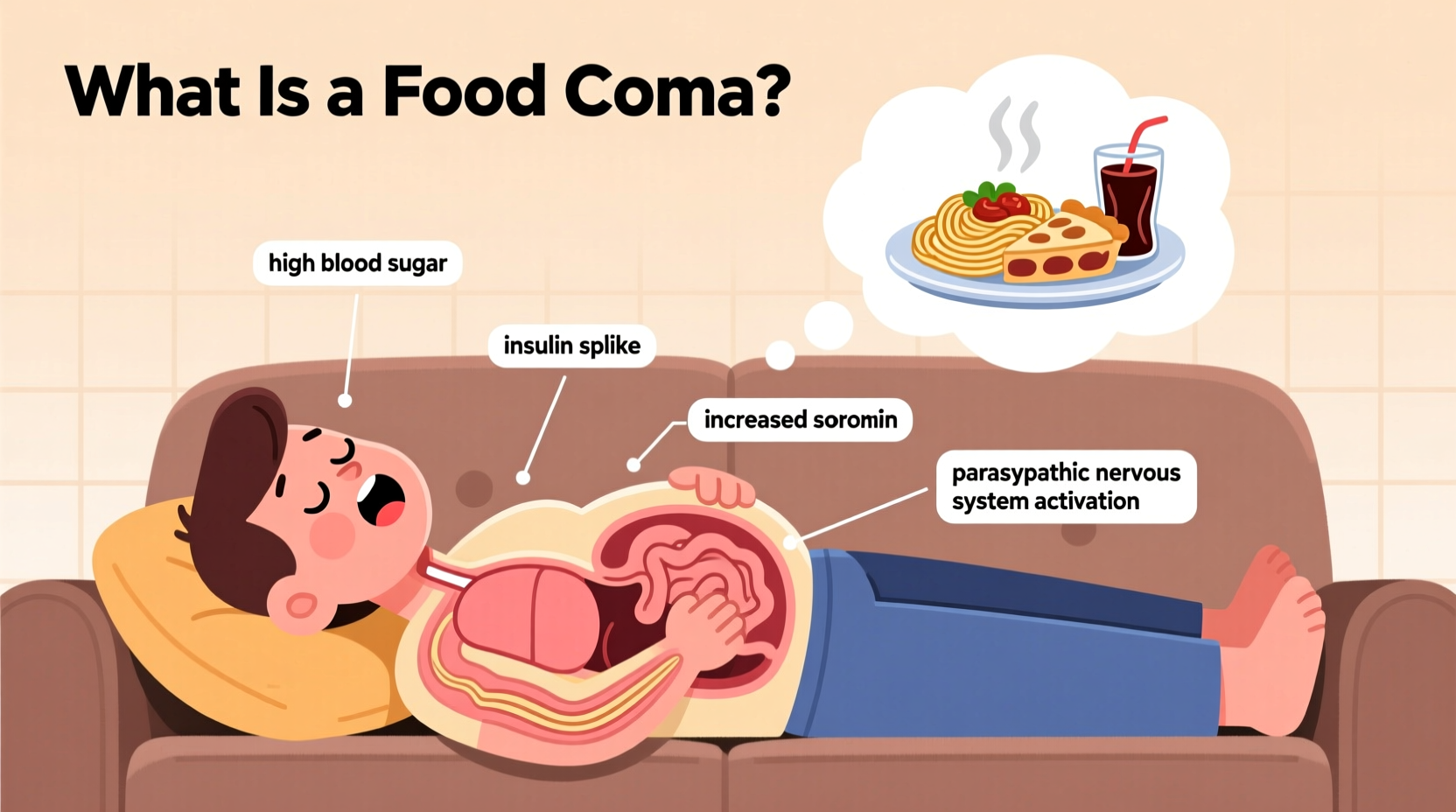Ever felt overwhelmingly sleepy after Thanksgiving dinner or a big lunch? You're not alone. That heavy, lethargic feeling isn't just in your head—it's a scientifically documented physiological response called postprandial somnolence. Understanding what causes food coma and how to manage it can help you maintain energy levels throughout your day without sacrificing enjoyable meals.
The Science Behind Food Coma: What Actually Happens in Your Body
When you eat, your digestive system springs into action. Blood flow redirects from your brain and muscles to your stomach and intestines to support digestion. This shift triggers several physiological changes:
- Insulin surge—Large meals, especially those high in carbohydrates, cause blood sugar spikes followed by insulin release, which can induce sleepiness
- Tryptophan availability—While turkey's tryptophan gets blamed, any protein-rich meal increases this amino acid that helps produce serotonin and melatonin
- Hormonal cascade—Cholecystokinin (CCK), glucagon, and other hormones released during digestion signal fullness and promote relaxation
- Parasympathetic activation—Your "rest and digest" nervous system takes over, slowing heart rate and promoting calm
According to research published in the American Journal of Clinical Nutrition, meals exceeding 1,000 calories can increase post-meal fatigue by up to 40% compared to moderate portions. The effect intensifies with higher carbohydrate and fat content.
Food Coma Timeline: When It Hits and How Long It Lasts
| Time After Eating | Physiological Changes | Typical Symptoms |
|---|---|---|
| 15-30 minutes | Insulin release begins; blood flow shifts to digestive system | Mild drowsiness, slight mental fog |
| 30-60 minutes | Peak insulin levels; tryptophan crosses blood-brain barrier | Noticeable fatigue, reduced concentration, yawning |
| 60-120 minutes | Digestive hormones peak; parasympathetic dominance | Strong urge to nap, heavy limbs, difficulty focusing |
| 2-4 hours | Gradual return to normal energy as digestion completes | Energy levels stabilize; mental clarity returns |
This timeline varies based on meal composition, individual metabolism, and circadian rhythm. A study from the National Center for Complementary and Integrative Health found that afternoon meals typically induce stronger food coma effects than breakfast due to natural circadian dips in alertness.
Which Foods Trigger the Strongest Food Coma?
Not all meals create equal drowsiness. Research shows these dietary factors significantly increase postprandial somnolence:
- High-carbohydrate meals—Especially refined carbs like white bread, pasta, and sugary desserts that cause rapid blood sugar spikes
- Foods rich in tryptophan—Turkey, chicken, cheese, nuts, and seeds (though tryptophan alone rarely causes significant drowsiness)
- High-fat meals—Fatty foods slow digestion, prolonging the body's digestive focus
- Large portion sizes—Meals exceeding 1,000 calories dramatically increase food coma likelihood
- Alcohol consumption—Even small amounts with meals intensify drowsiness

5 Science-Backed Strategies to Prevent Food Coma
You don't need to skip satisfying meals to avoid afternoon crashes. Implement these evidence-based approaches:
- Control portion sizes—Aim for balanced plates with ¼ protein, ¼ complex carbs, and ½ non-starchy vegetables to prevent blood sugar spikes
- Choose complex carbohydrates—Opt for whole grains, legumes, and vegetables that release energy gradually rather than refined carbs
- Include moderate protein—20-30 grams of protein helps stabilize blood sugar without excessive tryptophan effects
- Take a gentle walk—A 10-15 minute stroll after eating improves blood glucose control and reduces drowsiness, according to research in Diabetes Care
- Stay hydrated—Dehydration worsens fatigue; drink water before and after meals (not during to avoid diluting digestive enzymes)
When Food Coma Might Signal a Health Concern
While occasional post-meal drowsiness is normal, frequent or severe food coma could indicate underlying issues:
- Reactive hypoglycemia—Extreme blood sugar drops after meals causing weakness and confusion
- Insulin resistance—Your body struggles to process carbohydrates effectively
- Sleep disorders—Undiagnosed sleep apnea can worsen post-meal fatigue
- Food intolerances—Your body expends extra energy processing problematic foods
Consult a healthcare provider if you experience any of these warning signs:
- Frequent dizziness or lightheadedness after eating
- Sweating, trembling, or heart palpitations with post-meal fatigue
- Needing to nap after every substantial meal
- Symptoms interfering with daily activities or work performance
Food Coma Myths vs. Reality
Let's debunk common misconceptions about postprandial somnolence:
- Myth: Turkey causes food coma because of tryptophan Reality: Turkey contains similar tryptophan levels as other proteins; the large meal size and carbs are bigger factors
- Myth: Food coma means you're lazy or lack willpower Reality: It's a natural physiological response involving multiple biological systems
- Myth: Only overeating causes food coma Reality: Meal composition matters more than size—some people experience it after moderate portions of certain foods
- Myth: Coffee always counteracts food coma Reality: Caffeine may mask symptoms temporarily but doesn't address the underlying physiological processes
Practical Takeaways for Everyday Living
Understanding what is food coma and its mechanisms allows you to enjoy satisfying meals without afternoon crashes. Focus on balanced nutrition, mindful portion sizes, and strategic timing of larger meals. Remember that occasional postprandial somnolence is completely normal—your body is simply prioritizing digestion. By implementing these simple adjustments, you can maintain consistent energy levels throughout your day while still enjoying delicious, nourishing food.











 浙公网安备
33010002000092号
浙公网安备
33010002000092号 浙B2-20120091-4
浙B2-20120091-4